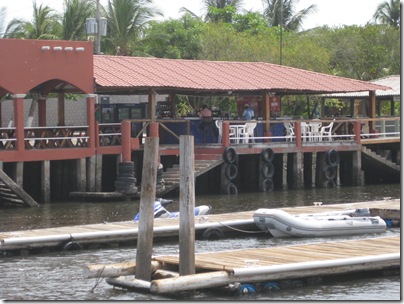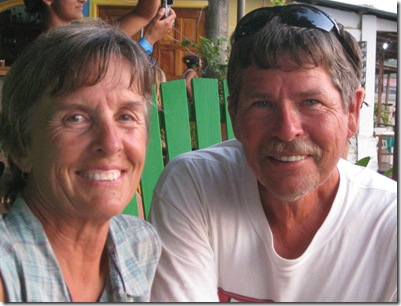We finally said goodbye to everyone at Bahia Del Sol, headed down river at 6 AM and across the bar with a pilot boat leading the way. We were moving along nicely about 2 hours later in very calm waters running just one engine when the engine coughed, sputtered, and quit. It was our own fault because I had just mentioned how well the motor sounded. We sailed south for two more hours trying to decide what to do and finally decided that the best idea was to turn around, catch the bar at Bahia at high tide again and get the motor fixed before we entered the wilderness known as Nicaragua .
We crossed the bar back at Bahia Del Sol again at 5 PM after a beautiful day of sailing (but not getting anywhere) and the faulty engine fired right up. With not enough caution I took this as a good sign, but as we tried to approach the dock in a very strong current the engine suddenly quit again leaving the boat with little control on one engine and in fast water. We barely missed hitting several very expensive boats before slamming into the dock. Luckily we came to a dead halt when we hit and several friends grabbed the boat and hauled her in. We thought we had put a hole in her, but the damage turned out to be mostly cosmetic (scratches, small dent, and lots of creosote). This was the worst landing of my life and the scariest. Rule #1 in boating… “Don’t hit the other guy’s boat”, and we narrowly missed hitting several.
The next morning we got a repair guy aboard and cleaned our carburetors thoroughly. The winter storage may have allowed a varnish buildup in the carbs as the gas dried and evaporated. That varnish (or just dirt) was blocking the small gas tubes. With both engines running we made plans to head out again just 48 hours after our first departure.
We had a 24 hour sail to Puesta Del Sol , Nicaragua where we checked into the country. Puesta is a remote location, over an hour by bus to a town, and we were limited to exploring on foot and walking the beaches. The huts and homes surrounding the marina were the poorest living conditions that we had encountered in our travels and it reminded us that Nicaragua is the second or third poorest country in the Western Hemisphere . It looked like a terrible way to live, but everyone was smiling and waving as we walked along the dirt paths that pass for streets.
A second 24 hour sail brought us to the town of San Juan Del Sur , Nicaragua . The anchorage was a beautiful broad bay with white sand beaches. We spent our first afternoon aboard because of the heavy swells and winds in the anchorage, but the next morning we headed for shore for a pleasant day exploring this legendary surf town.
The town was full of young Canadians and Americans who use Nicaragua as an inexpensive base for exploring Central America by bus. Hotel rooms ran about $15 and beers, while more expensive than some places, cost about a dollar. We have a tax client/friend living here who showed us around town and then treated us to cocktails at a beautiful sunset bar on the beach. Justin also warned us to be back on the boat before dark to avoid the possibility of petty theft while we were ashore. He keeps his own small boat in the anchorage for charter use, and he pays someone to sleep on the boat each night. He said the locals know the thieves, but in Nicaragua the attitude is “I don’t have much, he doesn’t have much, so why make trouble?” so the stealing just goes on. We have been warned that this is a continuing problem in all of Latin America , but nowhere more than Nicaragua and Costa Rica .

Nicaragua is a short coastline on the Pacific side so Costa Rica was our next destination. We had picked a remote, almost landlocked anchorage (Bahia St Elena, Lat 10 55, Lon 85 48) for our first stop that was less than 5 hours from Nicaragua . We got hit with big winds on the beam so the trip turned into a 3 hour fast sail, and we were thankful that we could sail right into an anchorage that was so well protected. Only one other boat occupied the bay that was at least a mile and a half deep and a mile wide. That afternoon and evening we got drenched with our first real rainstorm of the season… buckets of rain washing the salt and dirt from our decks.
Another heavy weather sail around an exposed Punta and we arrived in Bahia Culebra , Costa Rica. Snake Bay. This beautiful small bay had at least 6 good sand beaches to anchor and lots of clear, turquoise water. Anchoring is complicated a little by the changing wind directions. We try to guess where the wind will come from in the evening and then choose a leeward anchorage that will allow the islands or beaches to block the wind. Unfortunately this is a little like building a snow fort as a kid. You build a crude wall of snow waiting for a frontal attack and when you are all ready… WHAP! Someone hits you in the back of the head with a snowball. Wind shift. We did spend three nights in Culebra (well protected in our snow fort) and one night ashore in Playa del Cocos where we explored bars and restaurants.
The Gulf of Nicoya was now 120 miles south and one more overnight sail away. We had a memorable hour near Tamarindo where the winds went from calm to 30kts in less than 5 minutes and then almost exactly 60 minutes later dropped back to dead calm. We sailed the hour blow with a triple reef on the main, a reefed jib, and we still saw boat speeds of 11–13 kts. Mr Toad’s wild ride while it was happening followed by a “where did that come from?” when the winds suddenly died.
We are currently sitting at the Costa Rica Yacht Club in Puntarenas , Costa Rica. It is quiet here with only two visiting boats in the anchorage. We have been enjoying pool privileges, some nice dinners, and even intermittent internet access. The weather for all of this trip has been incredibly hot and now the humidity is rising. The steaming temperatures fall slightly with the afternoon rains, but overall this is a very warm place to be in May.
We have one more destination in Costa Rica and several anchorages planned along the way. We will pass close to Isla Del Cano which is reputed to be the place most frequently struck by lightning in all of Latin America . We have already seen some spectacular nighttime lightning storms (none too close) that produce almost continuous daylight in the distance. We do have our fingers crossed.




